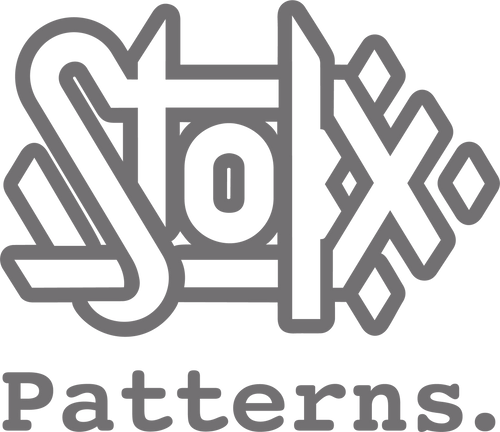Dear Ann,
Your questions really got under my skin... In a good way, Thank you!
1.Where did your business name come from?
My label is called “Stokx “ It is a phonetic version of
my last name Stokes.
It was /is often mispronounced by German speakers.
When I opened my shop I called it The Stokx Shop and now my patterns project
is called Stokx patterns , because they are..
2.How did you get started designing sewing patterns?
My mother sewed , my grandmother knitted and crocheted, my grandfather was a builder and my father was a draughtsman. I made things too.
When I decided to study fashion my mother said
“ at least you will learn how to sew..”
I also learnt how to make patterns.
3.What does your working space look like ?
My space always has a huge table.
It is 160 cm wide and 240cm long.
There is a roll of brown paper.
Now my table is in my shop.
There are lots of clothes here as well as drawers full of zippers, boxes of thread and Lots of fabric...
My table is the most important thing in my space.
4.Tell us about your process...
The best lesson I ever had was about draping.
I still find this method the best way to come up with something fresh.
I am always looking for something I haven´t seen before. I never start with a drawing when I make something new. I start with a problem I want to solve.
I take big piece of brown paper and go for it.
5.What is your biggest challenge?
To live from my creativity.
I have always invested in my work; moving forward; solving problems .
Our society has a weird way of assigning value. Often the ones who do the most work are paid the least. I want to shake things up !
6.What are your plans for 2021?
To unpack 30 years of knowledge and experimentation. To find a meaningful way to share my experience without exploiting myself or others.
Really Interesting, Here are some follow up questions..
1. I usually think of draping with fabric. You said you drape with paper. Is your draping process a little different or are you just able to skip the fabric step with your experience level?
I must have made a typo... I do hold paper up against my dummy sometimes; Just as I use paper to model angles of bags or 3 dimensional objects.Normally I use cloth when modeling the patterns for styles.
One example of this technique is the collar of the #stokxshirtdress (The same is also on the Athena Blouse).
So I start my process with a problem:
Here was the brief I gave myself. I wanted a dress that was easy to move in; that would suit most women; that had pockets; that was a comfortable length; that was button through ..... and DIDN´T look like a nurses uniform.
Nothing against nurses uniforms- they are ergonomic and very practical- but difficult to sell in a boutique.
Long story ,the beautiful chaotic collar came to be. As well as the saying that you have to "leave space for chaos"
2. Also how do you digitize your patterns? Do you take measurements of your paper pattern or do you import a photo?
I work with a lady who has a digitizer. These are in the process of being superseded by photo imaging.
The digitizer is about 150cm wide and 120 cm high.The surface of the digitizer is covered with fine wires in a grid mesh. The paper patterns are taped to the surface of the digitizer and then they are clicked around the outside and at crucial points with a kind of mouse.When clicking around the pieces, the points have to be identified as a curve, or a straight line or as a corner. This information is fed into a programme. My colleague uses Grafis. It is a computer pattern construction software that also includes a grading function. My pattern is opened and then linked to one of the standard patterns. If my pattern has a sleeve, then it will act like a sleeve. ie - grade like a sleeve.
There are standard grading measurement charts-- but you don´t have to accept them.
For example instead of packing extra width onto side seams, where there is no bust, I put extra width in the front .
There is a tricky feature called "x" value that is used a lot.
3. I am also very interested in your thoughts on living off your creativity. I am always shocked when someone buys my patterns full price on Etsy lol. Seems like everyone on Instagram wants things for free. I can’t even get people on there to pay me a dollar lol! It is my goal too to be compensated. I am not in the same boat as many of you as I am a disabled person so I do not have to make a living but I would like to make something for my expenses.
I seldom engage with those who, aren´t invested - I don´t just mean money- you are invested in me because you have taken the time to ask and have created a platform for creative people.Makers have invested their time and know what is involved in creative practice.
It is easy to have an opinion, but that opinion needs to be informed.
There are wonderful, open and friendly people on instagram and there are those
who think that running shoes are made completely by robots.
Years of having a shop has taught me that you can´t please everyone.
I have also had to learn this the hard way.
But there is only one way to go and that is forward.

